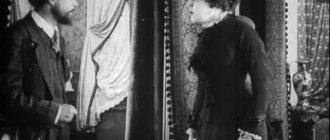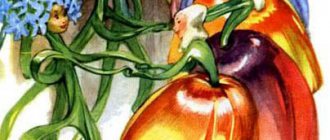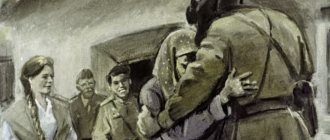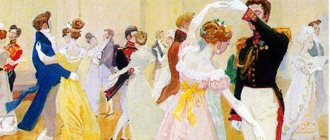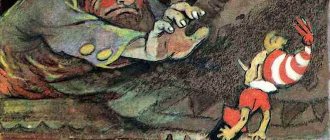- Summary
- Tolstoy Lev
- Canvas meter
The story of the great classic Leo Tolstoy “Kholstomer” begins with this picture. The groom drives the herd to the river, caresses Kholstomer's horse, and then, for no apparent reason, hits him painfully. However, the gelding is wiser than the man, the author notes. And the horse doesn’t show any offence, he just drinks water greedily.
The tired horse continues to be tormented by the herd. The herd is merciless: it pushes Kholstomer’s thin sides with its hooves only because he is old.
And then the author gives an amazing story from an exhausted horse about his life. The beautiful piebald gelding was born from the long-legged Holstomer. But because of the unusual coloring of the young Kholstomer, he is deprived of the opportunity to continue his family line, he is emasculated. The desperate horse endures this injustice and sadly observes the world of people. He sees how they endlessly lie, pretend, they are ruled by the law of “mine.” So Kholstomer’s owners disdainfully sell him to a visiting horse dealer, although thanks to his thoroughbred legs, Kholstomer is famous as the main trotter in the area.
Hussar, who now owns Kholstomer, is especially cool in his relationship with the wonderful horse. He drives the horse so that every passerby will shy away, seeing how the hussar rushes towards his mistress. And Kholstomer obediently serves his master and thinks: well, drive me to death, I will be glad to please you. Tolstoy tells how devoted the horse is to the hussar: Kholstomer admires himself next to the officer.
But then the hussar’s mistress leaves her gentleman. The owner saddles Kholstomer and drives him. Overnight, when the horse can no longer eat, it loses all its strength, and they begin to resell it to just anyone.
This is where the turning point in the story comes. The herd and the decrepit gelding return to the yard; there is a guest in the house, a flabby old man. The horse recognizes him as his once beloved hussar master. He squandered all his fortune, is completely in debt, and drunkenly falls asleep in one boot. So the author seems to compare the fates of a man who once drove a horse to death and an old gelding.
The ending of the story is creepy. He seems to be saying that since life has gone awry, it will continue to go this way until death. The scabworm is infected by the owner's horse. And they no longer take him to a watering hole, but lock him in a barn and cut his throat. But it seems to the horse that along with the stream of blood, the burden of life goes away. Dogs and wolves gnaw at the bones of the old gelding at night.
But Tolstoy immediately reports that the rotten body of the hussar was also removed into the ground, albeit later. Hiding this body in worms and a new uniform has become an unnecessary concern for people - the author notes with deadly calm. In these last lines, he seems to admit that revenge for the persecuted devoted Kholstomer has taken place...
You can use this text for a reader's diary
Tolstoy Lev. All works
- Shark
- Alyosha Pot
- Albert
- Anna Karenina
- The Battle of Austerlitz in the novel War and Peace
- Poor people
- Mad Dog
- The Battle of Borodino in the novel War and Peace
- Bulka
- Power of darkness
- War and Peace by volume
- Resurrection
- Chapter Natalya Savishna from the story Childhood
- Two brothers
- Two hussars
- Two comrades
- Childhood
- Devil
- Living Dead
- The Rostovs' name day in the novel War and Peace
- Confession
- Prisoner of the Caucasus
- Cossacks
- How geese saved Rome
- How a man divided geese
- Bone
- Kitty
- Kreutzer Sonata
- Swans
- Lion and dog
- Lipunyushka
- Lucerne
- Raid
- walnut branch
- Father Sergius
- Boyhood
- Petya Rostov
- The fruits of enlightenment
- Fire
- After the ball
- Righteous Judge
- Bounce
- Sevastopol in December
- Sevastopol stories
- Family happiness
- Death of Ivan Ilyich
- Old grandfather and grandson
- Three Bears
- Three deaths
- Morning of the landowner
- Filipok
- Hadji Murad
- Canvas meter
- Tsar and shirt
- How people live
- The Battle of Shengraben in the novel War and Peace
- Youth
Summary of Tolstoy's story "Kholstomer"
1886 Summary of the story Readable in 6 minutes, original - 1.5 hours
At dawn, the horses are driven from the master's horse yard to the meadow. The old piebald gelding stands out from the entire herd with its serious, thoughtful appearance. He does not show impatience, like all the other horses, he obediently waits until old man Nester saddles him, and sadly watches what is happening, knowing every minute in advance. Having driven the herd to the river, Nester unsaddles the gelding and scratches him under the neck, believing that this is pleasant for the horse. Gelding doesn’t like this scratching, but out of delicacy he pretends to be grateful to the person, closes his eyes and shakes his head. And suddenly, for no reason, Nester painfully hits the gelding on the dry leg with the buckle of the bridle. This incomprehensible evil act upsets the gelding, but he doesn’t show it. Unlike a human, the behavior of an old horse is full of dignity and calm wisdom. When young horses tease the gelding and make trouble for him - a brown filly muddies the waters right in front of his nose, others push and do not allow passage - he forgives his offenders with unfailing dignity and silent pride.
Despite the repulsive signs of decrepitude, the figure of the piebald gelding retains the calmness of its former beauty and strength. His old age is majestic and disgusting at the same time. And this causes indignation and contempt among horses. “Horses feel sorry only for themselves and, occasionally, only for those in whose shoes they can easily imagine themselves.” And all night in the horse yard, obeying the herd instinct, the entire herd chases the old gelding, the sounds of hooves hitting thin sides and heavy groaning can be heard. And the gelding can’t stand it, stops in helpless despair and begins a story about his life. The story lasts five nights, and during the breaks, during the day, the horses already respectfully treat the gelding.
He was born from the Gracious First and Baba. According to his pedigree, his name is Muzhik First, and in the street name, Kholstomer. That's what people call it because of its long and sweeping stroke. From the first days of his life, he feels his mother’s love and the surprise that it evokes in those around him. He is piebald, unusual, not like everyone else. The first grief in life is the loss of the love of a mother who already carries a younger brother. The first love for the beautiful filly Vyazopurikha ends, ending with the most important change in Kholstomer’s life - he is emasculated so as not to continue piebaldism in the family. His difference from everyone else gives rise to a tendency towards seriousness and profundity. The young gelding notices that people are guided in life not by deeds, but by words. And the main word among the words is “mine.” This word changes people's behavior, makes them often lie, pretend and not be what they really are. This word was the reason that the gelding was passed from hand to hand. Although he bypasses the famous trotter Swan, Kholstomer is still sold to a horse dealer: due to the fact that he is piebald and does not belong to the count, but to the equerry.
He is bought by a hussar officer, with whom the gelding spends the best time of his life. The owner is handsome, rich, cold and cruel - and dependence on such a person makes Kholstomer’s love for him especially strong. The owner needs a unique horse in order to stand out even more in the world, to ride to his mistress, to rush along Kuznetsky, so that everyone will stay away and look back. And Kholstomer serves selflessly, thinking: “Kill me, drive me, the happier I will be.” He admires the owner and himself next to him. But one rainy day, the mistress leaves the officer and leaves with another. The hussar, in pursuit of her, drives Kholstomer. He trembles all night and cannot eat. The next morning they give him water, and he forever ceases to be the horse he was. The canvas merchant is sold to a dealer, then to an old woman, a merchant, a peasant, a gypsy, and finally to the local clerk.
When the herd returns from the meadow the next evening, the owner shows the best, most expensive horses to the visiting guest. The guest reluctantly praises. Passing by Kholstomer, he slaps him on the rump and says that he once had the same “painted” gelding. Kholstomer recognizes his former beloved hussar master in the flabby old man.
In a manor house, in a luxurious living room, the owner, hostess and guest are sitting over tea. Former hussar Nikita Serpukhovsky is now over forty. Once very handsome, he has now declined “physically, morally, and financially.” He squandered a fortune of two million and still owes one hundred and twenty thousand. And therefore, the sight of the young owner’s happiness humiliates Serpukhovsky. He tries to talk about his past, when he was handsome, rich, and happy. The owner interrupts him and talks about his current life, bragging about what he has. This conversation, boring for both, in which they do not hear each other, continues until the morning, until Serpukhovskoy gets drunk and, staggering, goes to bed. He doesn’t even have the strength to undress completely - with only one boot still on, he collapses on the bed and snores, filling the room with the smell of tobacco, wine and dirty old age.
At night, the herdsman Vaska on Kholstomer goes to the tavern and keeps him on a leash until the morning next to the peasant's horse, from which the scab passes to the gelding. After five days, Kholstomer is not driven into the field, but is led behind the barn. When his throat is cut, it seems to him that, along with a large stream of blood, the whole burden of life is coming out of him. They skin him. Dogs, crows and kites take away the horse meat, and the she-wolf comes at night; a week later there are only bones lying around the barn. But the man then takes these bones away and puts them to use.
“Serpukhovsky’s dead body, which walked around the world, ate and drank, was put into the ground much later.” And to hide a rotting, worm-infested body there in a new uniform and cleaned boots was an unnecessary, unnecessary difficulty for people.
Previous
RetellingsSummary of Breton’s novel “The Seduced Villager”
Next
RetellingsSummary of Tolstoy’s story “The Death of Ivan Ilyich”
Popular retellings today
- Astafiev
V.P. Astafiev, a famous Russian writer, was born on May 1, 1924 in the village of Ovsyanka, Yenisei province. The boy had two sisters who died as babies. A couple of years later, the father of the future writer - Stevenson
Robert Louis Stevenson (1850-1894) is known throughout the world as a writer of the adventure genre. Born in Edinburgh, Scotland. The author is known for his adventure novels, and is also a significant figure in national neo-romanticism. - The Artamonov Case - a summary of Gorky's novel
At the very beginning, the author introduces readers to Ilya Artamonov. This is the head of the family. The man went to the city and wanted to build a factory there and start producing linen. Before that he worked for a long time - Sancho's faithful friend - summary of Yakovlev's book
The main character is Sancho Rodriguez. This is a teenager who came from South America to the Soviet Union. His parents work for an international company that supplied juice.
History of creation
Lev Nikolaevich Tolstoy, like any fruitfully working writer, often needed fresh ideas and stories.
The sources of many of them were people from the writer’s inner circle. Thus, the story of a gelding named Kholstomer, who actually once appeared at the Khrenovsky stud farm, was told to Tolstoy by the Stakhovich brothers, Alexander and Mikhail, with whom Lev Nikolaevich had long had a warm friendship. This happened in the 50s. Then Tolstoy did not take up the plot, because Mikhail Aleksandrovich Stakhovich, by the way, a well-known writer, poet, and ethnographer, was already working on its artistic treatment. In 1858, 38-year-old Stakhovich was killed by his own mayor and clerk for the purpose of robbery. The work about the trotter Kholstomer remained unfinished.
After another 5 years, Lev Nikolaevich Tolstoy took up the story, but after working a little, he left “Kholstomer” for more important matters (at that time, work was actively underway on “War and Peace”). And only in 1885, twenty years later, Lev Nikolaevich’s wife Sofya Andreevna Tolstaya found sketches of “Kholstomer” in his old papers and insisted that the story be completed and published.
Heroes and their characteristics
The main character is a horse nicknamed Kholstomer, the son of the noble Gracious First and Baba.
At birth he was named Muzhik First, and when he grew up, he was given the nickname Canvasser for his wide, sweeping stride. Once Kholstomer was valued, loved and respected, now that he has become old and weak, he is beaten and humiliated, he is the laughing stock of the horse yard. That’s why the expression on Kholstomer’s face is strictly patient, thoughtful and suffering. One day, having received another portion of undeserved beatings from the owner Nester, old Kholstomer begins to tell the story of his long and difficult life. His story lasts for five whole nights, during which time the inhabitants of the stable began to respect the venerable old man, and no one dared to grin in his direction.
Many years ago, life promised Kholstomer a great future - he was young, strong and fast, none of the inhabitants of the stable could compete with him in speed. There was only one thing that confused the owners of the stallion - his piebaldness (approx. piebald - having spots of a different color, motley).
When young Kholstomer fell madly in love with the pretty filly Vyazopurikha, he was castrated so as not to continue piebaldism in the family. So from a stallion Kholstomer became a gelding (approx. gelding is a castrated male horse, mainly used for agriculture and, unlike stallions, has a calmer disposition). Thus began his joyless life.
Attitude to owners Like most farm animals, Kholstomer was sold every now and then. During his long life, he visited a horse dealer, an old woman, a peasant, a gypsy, a clerk, but his most beloved host was officer Nikita Serpukhovsky.
The dealer sold Kholstomer to Serpukhovsky when the horse was still young, handsome and healthy. The officer, of course, did not harness Kholstomer to the plow. He put the dashing officer's equipment on the horse and set him off at full speed. Young Serpukhovsky led a very active lifestyle: constant carousing, dashing races and secret dates. It happened that the owner drove Kholstomer literally half to death, and he faithfully looked into Serpukhovsky’s face and adored him with every vein of his big horse heart. “With a hussar officer,” recalled Kholstomer, “I spent the best time of my life. Although he was the cause of my death, although he never loved anything, I love him precisely for this.”
One day, having caught his girlfriend cheating, Serpukhovsky sets off in pursuit of the fugitive and her lover. After the midnight gallop, Kholstomer trotted in the stall all night. The next morning his knee gave out. The officer abandoned the cripple, selling the horse for next to nothing to an old woman. And Kholstomer remained lame forever, he had to forget about driving fast and about his beloved owner.
True, years later Kholstomer and Serpukhovsky will meet. By that time, the officer will have gained weight and lost his former luster and grandeur. In endless carousings and love affairs, he will squander his entire fortune without achieving anything. Soon after this meeting, Kholstomer will pass away. Local animals will feed on its meat, and people will use its bones on their farms. All his life he was useful, and even after death his lifeless body became useful to someone.
Serpukhovsky's dead body was removed into the ground much later. He was buried in his uniform, with his boots cleaned, and a funeral psalm was read. Did Serpukhovsky do as much useful work as Kholstomer, abandoned in a dirty ditch? Probably not.
The main idea of the work
The story "Kholstomer" is very allegorical. Some realities are shown here through others. So, the image of a herd is human society, the horses in it are a blind and thoughtless crowd, blindly indulging in the rules invented by who knows who and who knows for whom.
The image of Kholstomer has two readings. On the one hand, this is a person who stands out from society. The canvasster becomes an outcast not because he is stupid, treacherous, angry, or deceitful. These qualities, unfortunately, are perceived by society as the norm, and in some cases they can even bring their owners into the ranks of leaders. The horse’s dissimilarity lay in reasons that were in no way dependent on him - he had the misfortune of being born piebald. “I was piebald, I was a gelding, and people imagined about me that I belonged not to God and myself, as is characteristic of all living things, but to them.” Just because he is an outcast (piebald), he is treated like a thing: they sell him, buy him, throw him away when he is tired of him, and mock him.
On the other hand, Kholstomer is a collective image of the typical features of a Russian peasant who works hard all his life in order to then die unknown. And the most terrible thing is that he does not rebel against his slave position, he only quietly grumbles and looks with suffering eyes into the heavens. He is strong, he is smart, he is brave and courageous, but he is submissive and this is his trouble. And no matter how paradoxical it may sound, he sometimes blindly loves his tormentor, just as Kholstomer loved the hussar Serpukhovsky.
So, Tolstoy’s main creative task was to show modern class society and its shocking injustice in an allegorical form. To depict a society where there is still slave labor, submissive service, where one can humiliate another with impunity.
Bullying a piebald
The old animals walked with a heavy, quiet step, and the young fillies crowded together, leaning on each other. Finally, all the horses went out of the gate, and the gelding, who perfectly remembered the route, dutifully took the herder to the meadow. When they reached the pasture, the worker unsaddled the gelding and began scratching him under the neck. Kholstomer didn't like it, but he pretended to like it . He behaved this way out of delicacy.
Suddenly Nester hit the gelding on the leg. It was very painful, but the piebald again did not show it. The horse was used to suffering, receiving insults from both people and horses, and the young fillies mocked him even more than the herdmaster. Kholstomer did not like his old age; it seemed disgusting to him. However, the appearance of the animal still retained traces of its former greatness.
For some reason, the young animals did not notice Kholstomer’s beauty. Light and carefree fillies perceived the gelding as a stranger, worthy of torment, but not pity.
When the horses returned from the meadow to the stable yard, the young mares continued to mock Kholstomer. They chased the old gelding and hit him in the sides with their hooves, but he just groaned like an old man. One mare hit him especially hard, and the gelding could not stand it: he bit the mischievous woman on the thigh. After that, something seemed to happen to the horses: they did not allow Kholstomer to eat or simply stand quietly. The whole herd was chasing the old man.
But then the gelding moved away from the youth and stopped in the middle of the yard. Then he did something that made everyone quiet. The piebald's face reflected despair, mixed with “the embitterment of powerless old age.” The horse sighed, and at that moment the old horse Vyazopurikha approached him. The rest of the youngsters came closer to them. They felt that they were about to learn something unusual from the gelding. Kholstomer paused and began his story.
